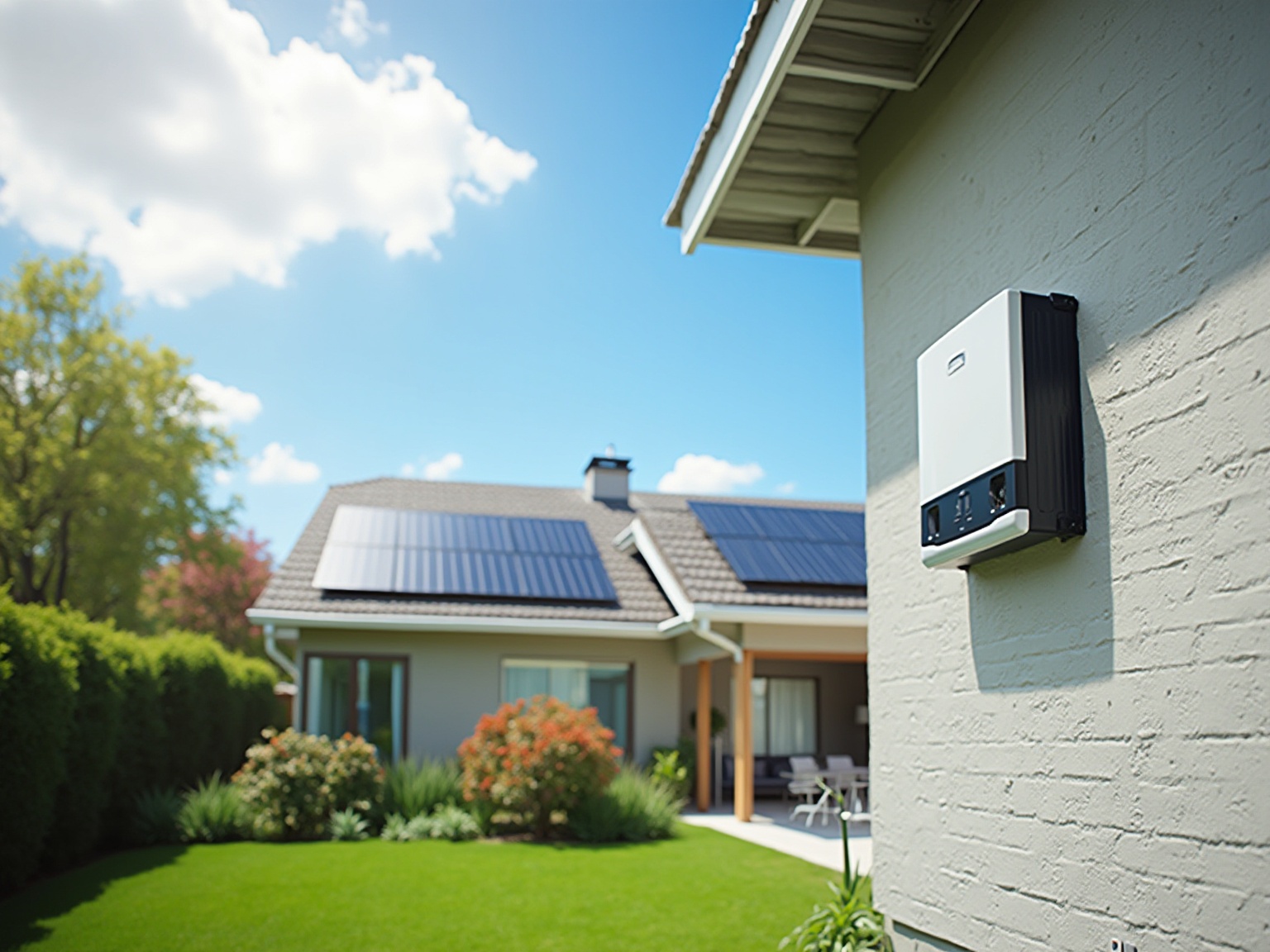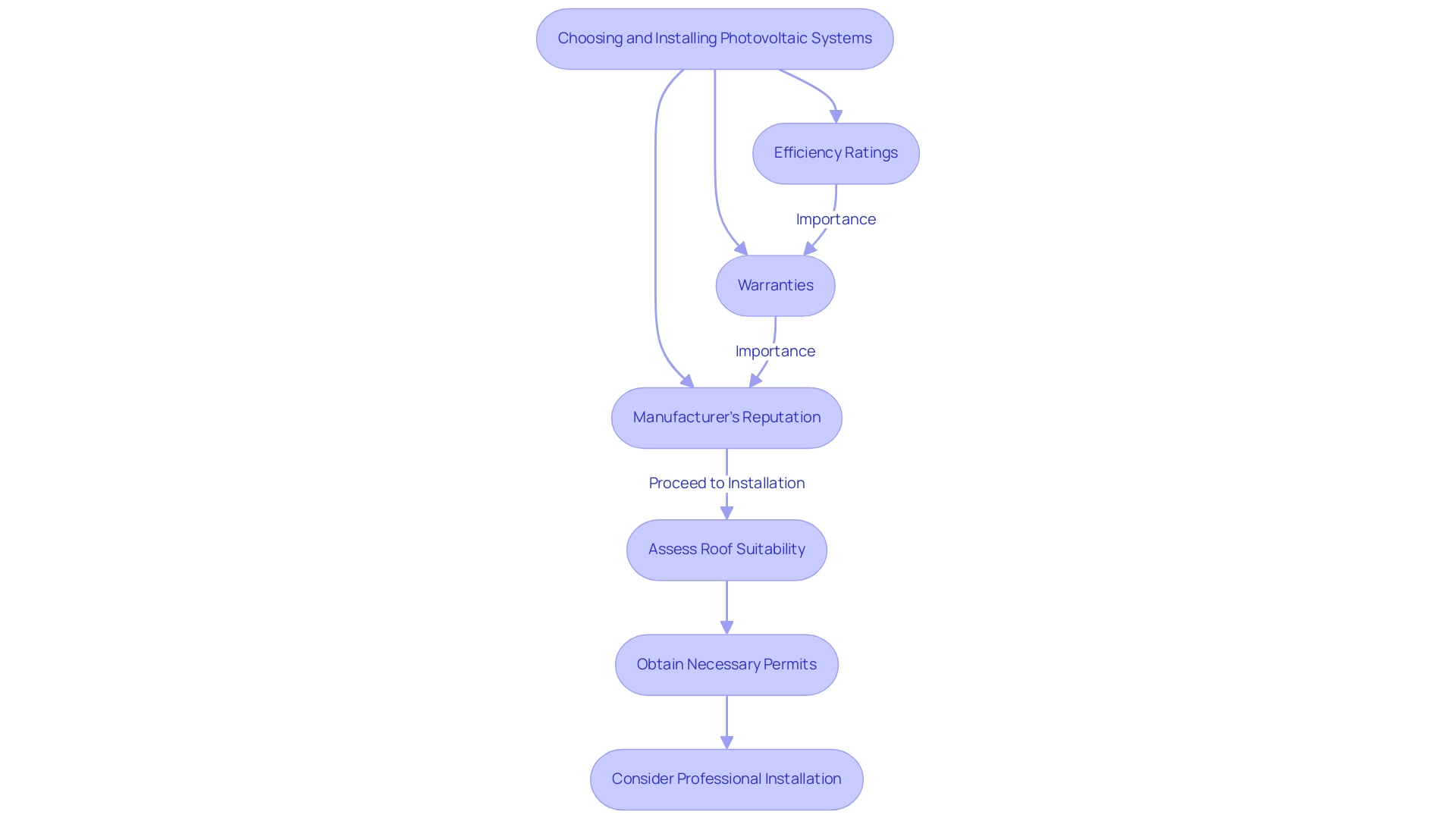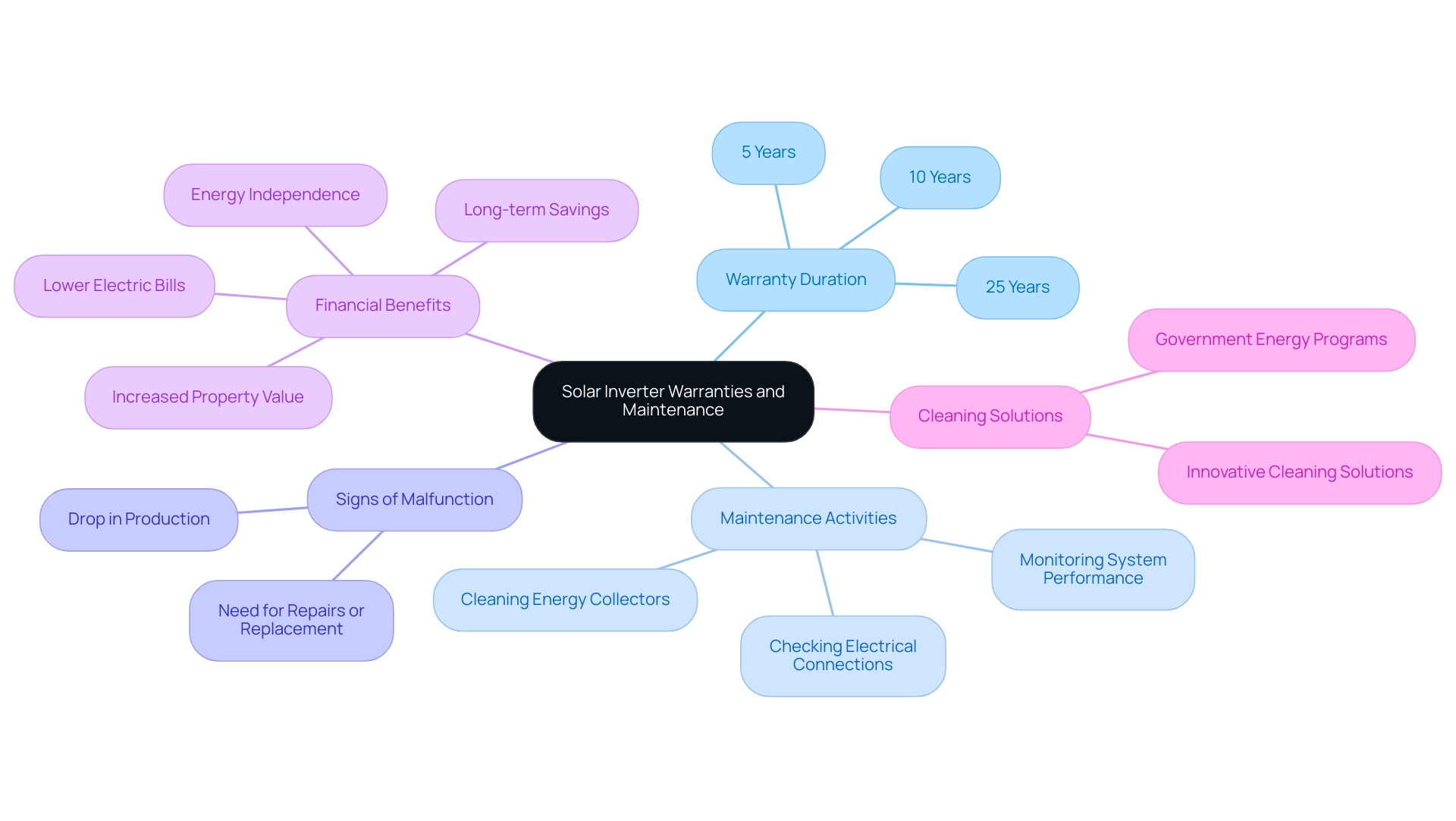Overview
Understanding solar panels with inverters is essential for homeowners aiming to adopt sustainable energy solutions, as these systems convert sunlight into usable electricity while optimizing energy savings. The article elaborates on the importance of choosing the right inverter type—string, micro, or power optimizers—along with considerations like efficiency ratings and compatibility, which significantly impact overall system performance and long-term benefits.
Introduction
In the quest for sustainable living, solar energy stands out as a beacon of hope, promising not only reduced electricity bills but also a significant contribution to environmental preservation. As homeowners increasingly turn to solar panels for their energy needs, understanding the intricacies of solar technology becomes paramount.
Central to this system are solar panels and inverters, which work in tandem to convert sunlight into usable electricity. While solar panels capture and convert sunlight, inverters play a crucial role in transforming the generated Direct Current (DC) into Alternating Current (AC), the standard electricity form used in homes.
This article delves into the essential elements of solar energy systems, exploring the various types of inverters available, their pros and cons, and best practices for selecting the right components to maximize efficiency and savings. As the solar market continues to expand, this guide equips homeowners with the knowledge needed to make informed decisions, paving the way for a cleaner, more sustainable future.
Introduction to Solar Panels and Inverters: The Basics
Solar modules, specifically a solar panel with inverter, function as the main tools that capture sunlight and transform it into electricity, a process essential for homeowners seeking to adopt sustainable power solutions. However, the capability of a solar panel with inverter is only part of the equation; converters play an equally vital role by changing the produced Direct Current (DC) electricity into Alternating Current (AC) electricity, which is the standard form used in residential homes. This transformation is crucial for the effective functioning of a renewable power system, allowing homeowners to operate their appliances efficiently, greatly decrease their electricity costs, and aid in creating a sustainable future.
When choosing a solar panel with inverter, homeowners should consider several best practices:
- Prioritize high-efficiency ratings for the inverter
- Ensure compatibility with existing panel systems
- Check the warranty and service support offered by the manufacturer
These factors can significantly affect the overall performance and lifespan of the renewable power system. As highlighted by recent forecasts from BNEF, the renewable energy sector is set to experience an average growth of 6% per year from 2024 to 2030, following an impressive 76% surge in installations in 2023.
This growth is enhanced by utility-scale prices for photovoltaic power currently varying from $16/MWh to $35/MWh, offering attractive financial incentives for homeowners to invest in renewable technology. Moreover, to ascertain the necessary power capacity for their residences, homeowners should evaluate their typical electricity usage by examining previous utility statements and taking into account aspects such as household size and efficiency measures. This method guarantees that the system is properly sized to fulfill their power requirements.
This trend highlights the growing dependence on renewable energy technology, making it essential for homeowners to comprehend the crucial function of a solar panel with inverter in optimizing their energy savings and ecological advantages, along with information regarding Tesla home chargers, government initiatives, cleaning services, and battery storage options.
Exploring Different Types of Solar Inverters: String, Micro, and Power Optimizers
A solar panel with inverter is essential for harnessing sunlight and transforming the direct current (DC) produced by photovoltaic systems into alternating current (AC) for home utilization. The three main categories of photovoltaic converters are:
- String converters
- Microinverters
- Power Optimizers
Each providing unique benefits suited to various installation requirements. String inverters are the most commonly utilized, connecting to a series of modules.
While they are cost-effective and straightforward, their performance can be compromised in shaded conditions, affecting overall efficiency. This limitation is particularly important to consider, as the International Energy Agency (IEA) highlighted that solar PV electricity generation is the second-largest contributor to electricity generation growth among renewable technologies in 2021. On the other hand, Microinverters are installed on each separate unit, allowing for independent operation.
This design enables them to perform exceptionally well in shaded conditions, as they optimize the output of each unit separately. As the market changes, specialists highlight that microinverters can offer a significant benefit in optimizing power generation when modules are not evenly exposed to sunlight. Power Optimizers function as a hybrid solution, improving the efficiency of string systems by maximizing the energy output of each panel.
They accomplish this by addressing the shading challenges that string devices encounter while ensuring a more straightforward installation process. This versatility makes them an attractive option for many homeowners looking to increase their system’s efficiency without the higher costs associated with microinverters. When choosing a power converter for their solar panel with inverter, homeowners should consider their specific conditions, such as the presence of shading from trees or nearby structures.
For properties with significant shade, Microinverters or Power Optimizers may be the best option to ensure optimal power production. Furthermore, if you are contemplating panel shingles, it is crucial to assess how these work with your power converter selection, as their performance may vary from conventional panels.
As of 2024, the photovoltaic converter market is expected to expand notably, fueled by progress in photovoltaic technology and rising demand for clean energy solutions. The worldwide market for photovoltaic devices was assessed at USD 16.3 billion in 2024 and is projected to attain USD 35.4 billion by 2033, indicating a compound annual growth rate (CAGR) of 10.2%. Furthermore, the GCC Countries market for photovoltaic devices is valued at USD 89.98 million in 2024, with a projected growth rate of 6.5%.
Likewise, the South Africa photovoltaic equipment market is anticipated to experience expansion at a CAGR of 6.7%, with a market size of USD 33.22 million in 2024. This growth will probably keep affecting the advancement and acceptance of various conversion technologies, as homeowners look for the most efficient solutions for their power systems.
Pros and Cons of Solar Inverter Types: Making the Right Choice
When choosing a solar panel with inverter, it is essential to understand the advantages and disadvantages of string models versus micro models, especially for eco-conscious homeowners looking to maximize solar energy. String devices are typically more budget-friendly and straightforward to install, making them a popular choice among homeowners. However, the efficiency of a solar panel with inverter can be significantly affected by shading or discrepancies in output, which can hinder the overall system performance, particularly in shaded wooded properties like those in Santa Cruz.
For instance, with an arrangement of 20 modules of 250 watts each, determining the appropriate converter size is crucial, as highlighted in the case study titled ‘Calculating the Right Converter Size.’ This case study highlights that the capacity of the solar panel with inverter should closely align with or slightly surpass the array’s peak power output for optimal performance. In contrast, a solar panel with inverter, such as microinverters, while generally more expensive—averaging around $14,619 for a 5 kW Enphase system—offers enhanced efficiency and operational flexibility, particularly suited for complex roof layouts or areas with shading.
They thrive in shaded environments, allowing that eco-conscious homeowners can capture as much sunlight energy as possible. Furthermore, photovoltaic shingles offer a visually appealing option to conventional systems, integrating effortlessly with roofing materials. However, they tend to have a higher initial cost and may provide lower efficiency compared to conventional systems.
According to industry expert Peter, ‘If you’re not happy with this, you can ask the installer to clarify why there wasn’t enough space and explain the rules that they worked with.’ Power optimizers can be effectively used with a solar panel with inverter, representing a viable compromise between the two; they improve performance without incurring the full cost of microinverters, making them an appealing option for many homeowners. Ultimately, the choice between these inverter types and roofing shingles, as well as the installation of a solar panel with inverter, depends on several factors, including budget limitations, roof design, and the particular shading conditions of your property.
Choosing the Right Photovoltaic Module and Inverter for Optimal Performance
When choosing photovoltaic modules, eco-conscious homeowners should prioritize several key factors: efficiency ratings, warranties, and the manufacturer’s reputation, especially considering the best modules for overcast days. For instance, products such as the SunPower Maxeon and LG NeON R are renowned for their high efficiency in low-light conditions, with efficiency ratings exceeding 22%. As the energy market evolves, understanding these elements becomes essential for optimizing system performance.
High-efficiency modules, particularly solar panels with inverters designed for suboptimal weather, can greatly improve overall power output when combined with suitable converters. Projections indicate that the efficiency ratings for photovoltaic modules in 2024 are expected to reach new heights due to advancements in technology and materials. It’s essential to consider the capacity of the solar panel with inverter; ensuring that it can manage the expected output of your panel array is vital for maximizing power production.
Furthermore, local renewable companies in Stockton can offer customized advice specific to individual power requirements, ensuring optimal performance and savings. For installation, homeowners should follow a step-by-step approach:
- Assess roof suitability
- Obtain necessary permits
- Consider professional installation for optimal results
In a swiftly expanding market for renewable power, characterized by a projected annual growth rate of 2%, homeowners have the opportunity to leverage recent insights into alternative power sources, including Tesla home chargers, government programs, and innovative battery storage solutions.
As Cristen Hemingway Jaynes emphasizes, the urgency for effective climate solutions is paramount, highlighting the importance of informed decisions in renewable energy investments. Additionally, with global PV power capacity having grown by 447 GW in 2023, homeowners can tap into renewable energy solutions that not only promise long-term sustainability but also significant economic and environmental benefits. Financial incentives, such as tax credits and rebates, can further enhance the economic feasibility of photovoltaic system installation, making it a worthwhile investment.
Understanding Solar Inverter Warranties and Maintenance Needs
Solar inverters typically come with warranties ranging from 5 to 25 years, depending on the manufacturer and model. Understanding these warranty terms is crucial for homeowners as they can significantly influence long-term performance and maintenance. Regular maintenance is crucial; routine upkeep activities involve:
- Checking electrical connections
- Cleaning energy collectors
- Closely monitoring system performance to guarantee optimal operation
Homeowners should be vigilant for signs of malfunction, such as a noticeable drop in production, which may indicate the need for repairs or replacement. To assist homeowners in this process, a user manual typically provides step-by-step maintenance procedures, including how to safely clean photovoltaic panels and check for loose connections. By proactively managing these aspects, including the selection of optimal battery options for power storage, homeowners can maximize the lifespan and efficiency of their inverters.
This not only secures financial benefits but also encourages independence in power. As the saying goes, ‘Yes, you will not only save money by going green, but you will become the owner of independent and clean energy.’ With electricity prices increasing at an average annual rate of 3.5% over the last five years, maintaining your inverter becomes increasingly critical for ensuring long-term savings.
Furthermore, incorporating innovative cleaning solutions and joining government energy programs can further enhance efficiency and sustainability. Homeowners are encouraged to refer to the user manual for specific troubleshooting tips and maintenance schedules to ensure their systems operate at peak performance.
Navigating Solar Panel Costs, Financing, and Incentives for Homeowners
The costs associated with solar panel with inverter installations can fluctuate significantly, influenced by factors such as system size, equipment type, and the complexity of the installation process. On average, homeowners might expect upfront costs for photovoltaic installations to be around $18,000. In comparison, conventional electricity costs can fluctuate significantly depending on usage and regional rates, often resulting in greater long-term expenses without the advantages of renewable energy.
Exploring various financing options such as loans, leases, and Power Purchase Agreements (PPAs) can provide tailored solutions to fit different financial situations, allowing for flexible payment terms that spread the initial investment over time. Moreover, substantial incentives are available to alleviate upfront costs, with current federal tax credits set at 26% until the end of 2033, subsequently reducing to 22% in 2034, along with potential state rebates. For eco-conscious homeowners, it’s advisable to obtain quotes from at least three different installers to compare prices, as location can significantly impact installation costs.
Collaborating with reputable installers not only ensures competitive pricing but also provides essential guidance in navigating financial options and maximizing available incentives. Comprehending local circumstances that influence expenses enables homeowners to make knowledgeable choices regarding their investments, ultimately improving the affordability and sustainability of their power solutions. Furthermore, the price of a Level 2 home charger usually varies from $500 to $2,000, based on the model and installation needs, which must be included in the total budget for EV integration.
This thorough method is particularly applicable for individuals contemplating the combination of a solar panel with inverter and electric vehicle charging alternatives, providing insights into the economic and ecological advantages of such systems. For Long Beach tenants, investigating community programs can also offer access to renewable power solutions without the need for a personal installation.
The Role of Solar Energy in Promoting Sustainability and Energy Independence
Investing in renewable sources goes beyond merely reducing individual carbon footprints; it is a crucial step toward improving autonomy. By harnessing the sun’s power with a solar panel with inverter, homeowners can significantly diminish their reliance on fossil fuels, thereby contributing to a cleaner environment and fostering the growth of renewable energy within their communities. Significantly, a 40-year-old rooftop energy collector in Vermont still functions at around 92% of its initial output, illustrating the longevity and robustness of renewable technology.
To maximize the output of a solar panel with inverter, homeowners should consider best practices for selecting the right inverters, such as:
- Ensuring compatibility with their solar panel with inverter system
- Evaluating efficiency ratings
- Considering the inverter’s warranty and reliability
Additionally, identifying the necessary power capacity for residences entails evaluating usage patterns, roof orientation, and local climate conditions to enhance installation. Further supporting this transition, Enel Green Power states, ‘We burn no fossil fuels, require no transportation for fuel, and use minimal amounts of water to produce power from our energy farms.’
This sustainable method not only aids the planet but also results in long-term financial savings through decreased utility costs. Remarkably, only 0.6% of the US land mass could supply power to the entire country with renewable resources, showcasing its viability on a larger scale. Homeowners should also consider the concept of dual-use energy systems, which integrate a solar panel with inverter and photovoltaic design, creating shared value for communities by allowing land to serve multiple purposes.
Moreover, the recent enactment of Massachusetts Senate Bill 2967, an important bipartisan initiative tackling challenges in the renewable sector and storage industry, indicates the increasing backing for sustainable initiatives. As renewable power becomes progressively competitive with conventional electricity sources, eco-conscious homeowners can confidently invest in this clean power solution, especially with incentives like the Investment Tax Credit (ITC) that enhance financial viability, paving the way for a more sustainable future. For Long Beach renters, exploring local solar programs and incentives can further facilitate access to these eco-friendly energy solutions.
Conclusion
Embracing solar energy is not merely a trend; it represents a significant leap towards sustainability and energy independence. Homeowners are equipped with the knowledge to navigate the complexities of solar technology, including the vital roles that solar panels and inverters play in harnessing the sun’s power. Understanding the distinctions between string inverters, microinverters, and power optimizers, along with their respective advantages and disadvantages, is essential for optimizing energy production and ensuring financial viability.
As the solar market continues to expand, driven by technological advancements and increasing demand for renewable energy solutions, it becomes crucial for homeowners to make informed decisions. Factors such as:
- Efficiency ratings
- Warranties
- Compatibility with existing systems
should guide the selection of photovoltaic modules and inverters. Moreover, regular maintenance and awareness of warranty terms can significantly enhance the longevity and performance of solar installations.
Ultimately, investing in solar energy not only contributes to environmental preservation but also offers substantial economic benefits. With financial incentives and various financing options available, homeowners can make the transition to solar power both affordable and impactful. By leveraging these resources and embracing sustainable practices, individuals can play a pivotal role in advancing the clean energy movement, ensuring a brighter and more sustainable future for generations to come.




